Table of Contents
ToggleIntroduction
The Asus A7N266-C in this review features nVidia's very first motherboard chipset, called “nForce”. The chipset is a classic two-chip solution, with several versions existing of both the northbridge and the southbridge. Asus brought various versions of the A7N266 to the market, with different combinations of the available north- and southbridges. The following models exist:
- A7N266
Full ATX, nForce 420-D, MCP Southbridge, dual channel memory, integrated graphics, no Soundstorm audio
- A7N266-C
Full ATX, nForce 415-D, MCP-D Southbridge, dual channel memory, no integrated graphics, Soundstorm audio
- A7N266-E
Full ATX, nForce 420-D, MCP-D Southbridge, dual channel memory, integrated graphics, Soundstorm audio
- A7N266-VM
Micro ATX, nForce 220-D, MCP-D Southbridge, single channel memory, integrated graphics, Soundstorm audio
The nForce was the first consumer-chipset for DDR memory, that offered a dual channel memory interface. It is also very feature-rich in general, which made it a rather costly solution compared to contemporary VIA chipset based motherboard for example.
Furthermore, it was the first Socket A chipset to break compatibility to older graphics cards like the Voodoo 5 or the Rage Fury MAXX for example, because its AGP slot does not offer 3,3V voltage, but 1,5V only.
Gallery
Specifications and Features
Chipset:
- nVidia nForce 415-D SPP Northbridge
- nVidia MCP-D Southbridge
CPU Support (with latest BIOS):
- Athlon Thunderbird (ALL)
- Athlon XP Palomino (ALL)
- Athlon XP Thoroughbred (all FSB266 models up to 2600+)
- Athlon XP Thorton (all FSB266 models up to 2400+)
- Duron Spitfire (ALL)
- Duron Morgan (ALL)
- Duron Applebred (ALL)
Memory Support:
- 3 DDR DIMM slots, up to 1,5 GB total
Expansion Slots:
- 1x AGP Pro slot (1,5V) up to 4x
- 5x PCI slots
- 1x ACR slot
Connectors (internal):
- 2x IDE (UDMA100)
- 1x Floppy
- 4x USB 1.1
- 3x 3-pin fan connectors total (1x CPU, 2x chassis)
Connectors (external):
- 2x PS/2
- 1x RJ-45 10/100 Ethernet
- 1x COM/RS-232
- 1x Parallel Port
- 2x USB 1.1
- Gameport
- 5x 3,5" Audio Jacks (Front, Center, Rear, Line In, Mic) (via ACR-A6CH audio card)
- S/PDIF digital Coax out
You might have noticed, that I didn't mention the audio chipset specifically, as I think far better solutions than the old onboard chipsets are readily available for little money. Very commonly recommended are the Creative Soundblaster Live! cards for example, which offer fantastic compatibility with our beloved old games and sound far better than any onboard solution of that era.
I also don't list (from a retro-gamers perspective) useless connectors and features like IR, Smartcard- or Wake-on-LAN connectors and so on.
Overclocking Features:
- Adjustable Multiplier (BIOS) from x5 to x12,5
- Adjustable FSB (BIOS) from 100 - 115 and 133 - 181MHz in steps of 2-3 MHz; fixed PCI clock
- Adjustable VCore (Jumper) from 1,675 V to 1,850 V in 0,025 V steps
- DDR Voltage (Jumper): 2,5 V / 2,6 V / 2,7 V
There is also a “Over Volt” Jumper on the board, which is not mentioned in the manual. Maybe this was added in later PCB revisions? In other Asus boards of that time that officially have a jumper like that, an offset of +0,300 V is added to the configured VCore. So I configured the lowest possible VCore (which was 1,700 V real) and set "Over Volt" to enabled. The system posted fine, but when I tried to enter the Hardware Monitor in the BIOS, the system froze instantly. Since I do not know, how much voltage this actually adds and I do not want to damage something, Ieft the jumper alone in my further testing.
Documentation, Downloads, Drivers
Hardware and BIOS aside (for the moment) - the first big positive aspect when you chose a mainboard of a still existing manufacturer for your retro build, is, that you'll most likely won't have too much trouble finding documentation and BIOS files.
The support site for the A7N266-C can be found easily when you go to your search engine of choice and type "a7n266-c support".
Asus still offers the manual, the latest BIOS versions and even drivers for download. The drivers are incomplete and outdated, however. Moreover, the driver for the Realtek LAN chip is unavailable for any OS listed and for Windows 98SE, the audio driver is missing. But since the LAN driver can be easily obtained from Realtek directly and the audio driver gets installed during the nVidia chipset driver installation, this is not a huge issue.
Unfortunately Asus does not bundle a BIOS flash tool with the BIOS downloads and the utility is also not available for download in the BIOS & Firmware download section of the support page. The required "Aflash" utility can be found under Driver & Tools - there you have to select "Others" at the "Select OS" drop-down list:
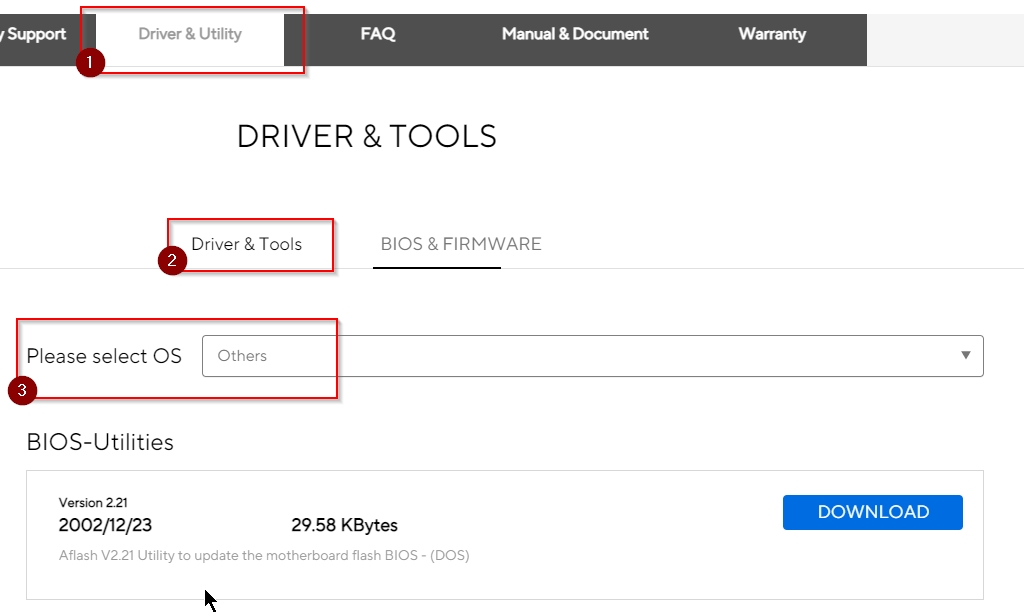
There is also a CPU support list directly on the board's support page, where you can easily look up compatible CPUs for the A7N266-C.
On top of that, Asus also offers a global CPU Support search. Here you are not only able to search for a specific mainboard model but also the other way round: If you have an old CPU laying around, you can use the search form to find compatible mainboard models and maybe to get inspiration for your next retro build.
You can find it here: https://www.asus.com/support/cpu_support
Design & Layout
The layout of the A7N266-C is not perfect, but it is almost flawless. I like the fact, that the IDE and floppy connectors are placed nicely on the edge of the board and that the CMOS battery as well as the socketed BIOS chip are also in the same location. Expansion cards of almost any length can be installed without them covering locations you might need access to when the system is already put together, like jumpers, connectors or the CMOS battery for example.


The ATX power connector could have been placed a bit more towards the upper right corner for my taste, but it is still located pretty good behind the IDE connectors.
Another positive thing to mention is the position of the memory slots. There is enough space kept between them and the graphics card, so that the memory modules can be installed and removed while the videocard remains installed.
The A7N266-C also offers lots of space around the CPU socket, so we can expect very little trouble in that department. I tested the following eight CPU coolers towards compatibility:
- Thermaltake Silent Boost K7
- Cooler Master HHC-001
- Swiftech MCX 370
- Alpha PAL 6035
- Alpha PAL 8045
- Smartcooler 60mm
- Arctic Cooling Copper Lite

The only model that might cause problems is the Cooler Master HHC-001. Like on virtually every motherboard with the CPU socket oriented this way, the lever of its mounting bracket might make contact to the PSU if it sits very close to the board. But apart from that, all coolers were easy to install and fit fine.
The two things I do not like about the A7N266-C's layout, however, are the positions of the extra fan headers and the multitude of jumpers found on this board.

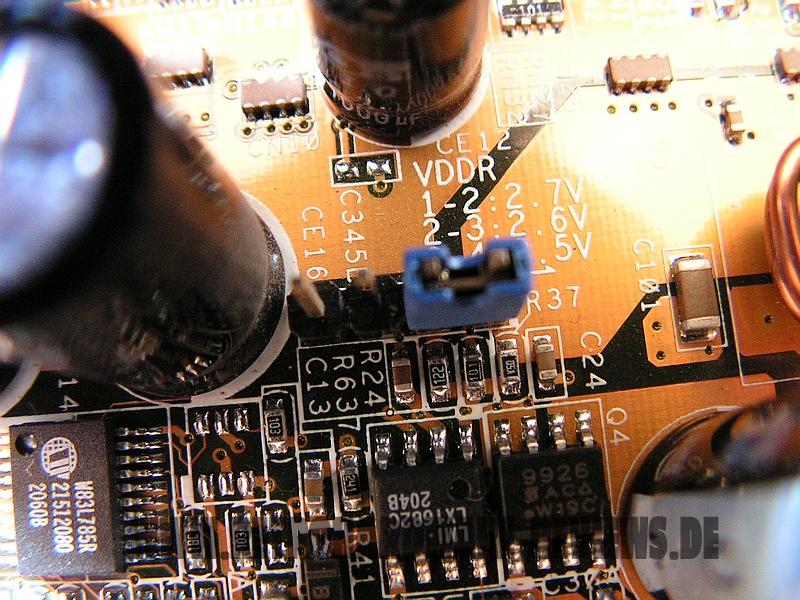
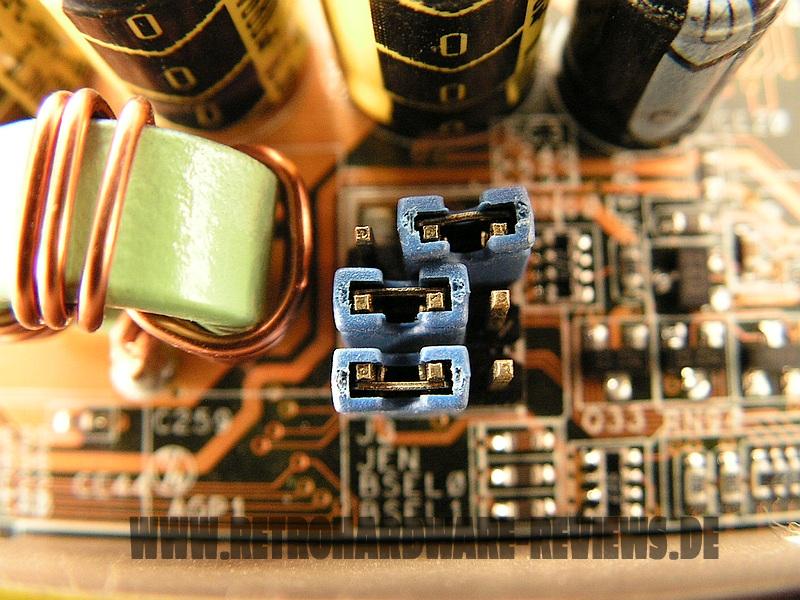
Both of theses are aspects that shouldn't come up with such a “modern” board in my opinion. It may be a design decision to offer jumpers to adjust the multiplier and, to be fair, the board can be set to "Jumper Free Mode! (via a jumper! :P) where at least the FSB and multiplier can be configured in the BIOS. But then again, all voltages (VCore, VDIMM) can only be configured using jumpers - this simply inconsistent and was done much better by other manufacturers like Abit and Epox on several boards of that time.
Test-System and Parts
Baseline Setup:
- CPU: AMD Athlon Thunderbird 1200C (FSB133)
Because I want to compare 1st Gen Socket A mainboards to their DDR follow-ups I have to use a CPU, which is available in FSB100 and FSB133 versions with the same clockspeed. Since I sadly don't have a Thunderbird 1400 B at my disposal, I will use the Thunderbird 1200 for my reviews and comparisons of these boards, which I have in the “B” (FSB100) and “C” (FSB133) version.
- RAM (single channel): 1x Corsair CMX512-3200C2 (XMS3202v4.2) = 512MB PC400 CL2
This Corsair XMS stick should allow the tightest timings at 266 MHz DDR and its size of 512MB is the perfect choice for Windows 98SE
- RAM (dual channel): 2x Kingston Hyper X KHX3200/256 = 2x 256 MB PC400 CL2
I additionally tested the A7N266-C in a dual channel configuration. The two Kingston sticks also give 512 MB of total memory and accept very fast timings.
- VGA: MSI Geforce 4 TI4200-VTD8X
To remove any GPU bottleneck for testing, I chose a Geforce 4 Ti as the primary graphics card for my test setups. The Geforce 4 Ti series are also known to pull a lot of power from the AGP port, so that possible problems in that department can also be revealed. It is also somewhat period correct and a good match for a high performance retro-machine that should be able to run late Windows 98SE games without any issues.
- VGA2: none
Since the A7N266-C does not support 3,3V AGP voltage, I cannot test the Voodoo 5 as usual.
- Audio: Creative Soundblaster Live! (SB0060)
Creative's Soundblaster Live! can be found in many retro-machines. It offers great sound, perfect Win98SE compatibility and is still widely available for reasonable money. It was also known to cause problems with VIA-based 686B southbridges using old BIOS revisions and VIA chipset drivers. All this should be history at this point, but double checking on pontentially affected mainboards is still not a bad thing to do.
- LAN: Onboard Realtek 10/100
Since the A7N266-C features an onboard NIC, there is no need for an PCI card.
- HDD: Western Digital WD200BB (20GB 7200RPM)
No special intention behind this drive, it is just “there” and still works fine.
Additional Hardware for certain Tests:
- Silicon Image Sil3512 SATA Controller & Samsung PM871 128GB SSD
These two will help me measure the PCI bandwidth.
- Hitachi Deskstar T7K500 (500GB 7200RPM)
This drive will tell us, how big we can go with the onboard IDE connectors and how the performance is like.
- 2x Voodoo 2 12MB (SLI)
A pair of Voodoo 2s is a must have for any retro-machine, that doesn't feature a 3dfx card as the primary VGA solution. They offer compatibility to older Glide games and can be used with any more powerful primary graphics card. It is an important thing to know, how well these perform and if there are differences between all the available Socket A chipsets of that era or even between boards using the same chipset.
Drivers used:
- Chipset: nVidia nForce driver 2.41
- Geforce 4: nVidia Forceware 43.45
- Voodoo 2: FastVoodoo 4.6
- SB Live!: Some driver from my archive, not shure 😉
- 3Com NIC: Windows 98SE preloaded driver
- SATA Controller: Some driver from my archive, not shure 😉
System Setup and Usage
The initial setup of the A7N266-C was a bit bumpy. This had mostly to do with memory related issues. I defenitely wanted to bench this board both in single- as well as in dual channel memory configuration, but of course I wanted to limit the maximum memory installed to 512 MB in total, to maintain comparability to the other boards tested.
And this proved to be difficult and confusing for several reasons. First of all, I have very few “High End” DDR1 sticks with only 256 MB of size to choose from. Fortunately, my two 256 MB Kingston Hyper-X PC400 CL2 sticks were detected without problems. However, since these are single-ranked modules, they are not the optimal choice for the nForce, as I found out later.
Secondly, the memory settings offered in the A7N266-Cs BIOS are limited to several “CAS Latency” presets (2T Normal, 2T Turbo, 2,5T Normal, 2,5T Turbo, Auto) and this does not always translate to identical memory timings for the same setting, but changes with different memory modules installed.
For example: my two Kingston Hyper X 256MB modules run at CL2 2-2-4 when configured to “CAS2 Normal”. “CAS2 Turbo” does not work. My Standard Corsair XMS 512MB PC400 stick gets CL2 2-2-6 applied with the “CAS2 Normal" setting, in “CAS2 Turbo” mode, the resulting timings are CL2 2-2-5. This is also true, when I install a second Corsair stick for dual channel configuration.
So with the hardware I have at my disposal, I am not able to compare dual and single channel mode with the same memory timings applied. But this is actually not the biggest of problems, because the dual channel configuration is barely faster than the single Corsair stick, so that I initially even thought, dual channel wasn't active at all.
The BIOS POST does not show the active memory configuration, which does not help either of course. And since AIDA64 also reported the memory interface to be 64Bit, I really thought it was inactive. I tried different memory configurations, configured all BIOS settings related to memory to “Auto”, tried older BIOS versions - the results were always the same. Insidiously, the performance of the two Hyper X sticks in dual channel configuration was pretty similar to the performance of a single Corsair XMS stick, so I didn't consider another possible configuration (which seems logical now), which is of course testing a single Hyper X stick.
And this finally yielded notably worse performance results, so I had the confirmation - dual channel actually works. I am shure, that the performance of two dual-ranked modules would result in the best performance, but this also shows that a single memory stick can match the performance of two sticks running in dual channel configuration, depending on how they are organized internally.
There is another thing I want to mention (before I close the memory “chapter”). I was actually very lucky to have the board POST with the Corsair XMS v4.2 stick - as I found out during my BIOS flashs, the board seems not be able to POST with this memory module, when all memory settings are configured to “Auto”. When I first installed the XMS v4.2 stick, the timings were still set to “CAS2 Normal” from the Hyper X sticks before. So it runs the tightest timings without problems, but the A7N266-C seems to be unable to negotiate timings, when this stick is installed. An XMS v5.1 stick worked fine however, also with “Auto” settings.
After I sorted all memory issues out, I went on to the expansion cards. The first thing I was happy to see in the manual, is, that the nForce offers five INT-lines and that the AGP port exclusively uses INT-E and is not shared with any PCI slot. According to the INT table in there, PCI #1 und #5 are shared and also share their IRQ with the ACR slot / the onboard audio. PCI #2 is shared with the USB controllers, PCI #3 is shared with the onboard LAN chip and PCI #4 is sharing-free.

Within this process, I discovered that there is no way to disable the onboard LAN chip. While this is not to much of a problem for my testing (I just used it instead of my usual 3Com PCI card), I think the option should be there and I can't understand why it isn't. In my opinion it should be possible to disable ANY onboard component that isn't required for regular operation. Anyway - my setup for during the review was like that:
- PCI #1: free
- PCI #2: Voodoo 2
- PCI #3: Voodoo 2
- PCI #4: SATA controller
- PCI #5: SB Live!
I disabled all unneccessary onboard components and, as expected, this resulted in no shared IRQs. So far so good.
But the next problem I encountered, already occured during the nForce chipset driver installation. It is important to know, that nVidia's driver package contains the drivers for all onboard components (including audio, LAN and graphics drivers). However, unlike other integrated drivers (like VIA for example), you cannot select which drivers are actually installed during the setup process.
Although the onboard audio was disabled, the setup tried to install the audio drivers, which took forever and eventually led to an error message during the setup process (data cannot be copied..). While this can be acknowledged and the setup completes, it is still not very “refined”. Moreover, nVidia graphics drivers are also installed, although the A7N266-C has no integrated graphics at all. On top of that, the chipset drivers do not automatically enable DMA mode, so you have to set it manually after the reboot and.. reboot again.
Fortunately, all benchmarking went fine once the drivers were installed and I did not experience any further issues.
Benchmarks
Synthetic Measurements
Before we get into the 3DMark and gaming benchmarks, let's have a look at some theoretical numbers. These synthetic tests will exhibit the differences between the several chipsets and boards better than any game benchmark and provide us with "background information" that might be of use in understanding the timedemo results later.
Memory Performance: AIDA64 Cache & Memory Benchmark
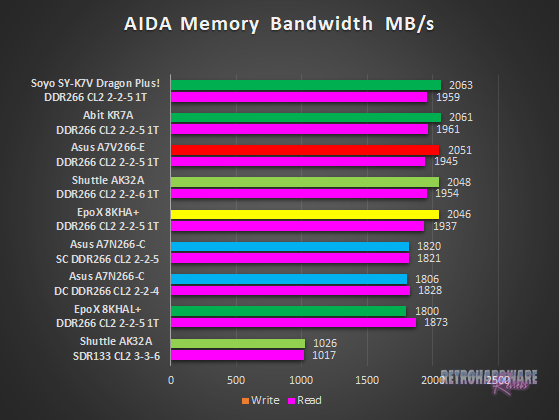

Like explained in the previous chapter, the nForce chipset would need two dual-ranked modules in dual channel memory configuration to reach its full potential, but I don't have those in such small sizes. We'll see throughout the benches, that a single dual-ranked memory module is very comparable in performance to two single-ranked modules in dual channel configuration.
With a VIA KT266A based board, you don't have to worry about the internal organization of your memory modules either - and since this chipset was the nForce's main competitor, the A7N266-C will have to hold its ground with what is available at the time of review 😉
Starting with the AIDA Memory Bandwidth test, things don't look to bright for the Asus board. Most KT266A based boards show a higher memory throughput, which can be more than 10%, especially in write speeds. I suspect, that the A7N266-C could roughly equalize that with dual-ranked memory modules in dual channel configuration, but I don't see it perform better than the faster KT266A boards.
In the memory latency test, the Asus board shines. It is able to outperform all boards but the Abit KR7A and ranks second and third with the two memory configurations. The dual channel memory configuration is the slightly faster option here.
Application Performance: 7-Zip

The A7N266-C clearly dominates this benchmark. Despite its slight disadvantage in CPU clock speed, it ranks first and second with both memory configurations, which perform nearly identical.
AGP Performance: Final Reality Benchmark
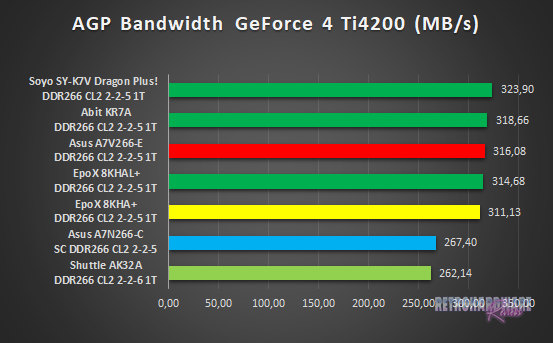
The AGP bandwidth is the second lowest of the tested boards. This is a little unexpected, since nVidia chipset and nVidia graphics card should work great together in theory. Even more so, because this is a fairly period-correct combination.
AGP and PCI Performance: 3DMark 2000 and ATTO
3DMark 2000 as a whole is very focused on TnL and is by far not as interesting for retro-hardware comparisons as its predecessor. Its “High Polygon Count, 1 Light” test, however, is another good way to measure the AGP performance. In opposite to the Final Reality test, the general system performance is also somewhat of importance. The benchmark was executed with the Geforce 4 Ti installed.
To measure PCI performance, I installed a Windows 98SE compatible SATA controller with a Samsung PM871 128GB SSD connected into the system. For the bench, I chose 1024 to 4096 KB block size and picked the overall best values for the read and write throughput. This test will show, which maximum performance can be expected with fast storage options like SATA or SCSI and maybe gives a hint, if the chipset might be good for Voodoo 2 cards.

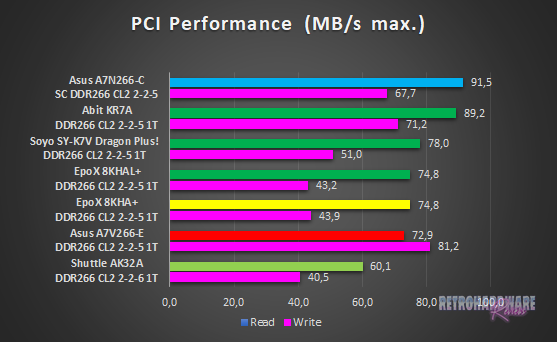
3DMark2000's subtest shows equally lacking performance of the nForce board,. The Asus A7N266-C ends up in last place, more than 10% behind the fastest KT266A based board.
Its PCI performance is a different story, however. With the highest read- and third highest write throughput, it has one of the best performing PCI busses of the boards tested.
Storage Performance: HDTach
To measure the performance of the board's IDE and (if available) onboard IDE RAID solutions' performance, I benched one of the latest and fastest IDE drives (the Hitachi Deskstar T7K500 500GB) with the HDTach benchmark. I also tried a much more “recent” drive (the Western Digital Blue Edition 500GB), which should be even faster in theory, but the Hitachi drive produced much better results in this test.

The A7N266-C shows excellent IDE performance, only the EpoX 8KHAL+ with the ATA133-enabled VIA VT8233A southbridge is faster.
Gaming Benchmarks
Now that we got all the theoretical performance numbers, let's see how the contenders perform in 3D gaming benchmarks.
3D Performance: 3DMark99max
3DMark99max was released in early 1999 and comes without support for Hardware TnL. The maximum supported (hardware-) DirectX level is DX6. It is a great benchmark to reveal good overall system performance, as it rewards good memory bandwidth and latency more than the slight clockspeed advantage, that some boards have because of their factory-overclocked FSBs.
- Version: "latest"
- Settings: standard
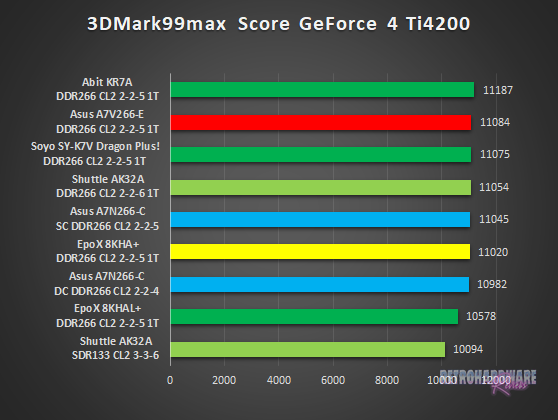

Taking the slightly lower CPU clockspeed of the A7N266-C into account, the Asus board performs about the same as a well running KT266A based board with the Geforce 4 Ti installed. The single channel memory configuration is the faster option here.
This is not the case with the pair of Voodoo 2 cards installed, the nForce chipset seems to have serious issues with the 3dfx cards here. Since the board's PCI throughput in general is pretty good, there might be a general compatibility issue.

Even though the CPU clock on the A7N266-C is the lowest of the boards tested, it is the undisputed winner in terms of CPU performance in 3DMark99max. The two memory configurations rank first and second, with the single channel variant being the faster option once again.
3D Performance: Unreal Tournament (UT99) Timedemo(s)
Unreal Tournament (UT99) was released in November 1999 and is notorious for its hunger for CPU power. I chose to use two different timedemos for comparison, of which the utbench.dem timedemo is heavily CPU bound and therefore qualifies to measure the general performance of the boards. The second timedemo benchmark.dem is as GPU limited as possible in this game. This will reveal, how much impact a faster board can still have in more GPU limited situations. This game is also perfect to show, on which chipsets and boards Voodoo 2 cards run best.
- Version: 4.36
- Settings: High, Min desired Framerate "0", Show Decals [x], Use Dynamic Lightning [x]
- Geforce: D3D
- Voodoo 2 and Voodoo 5: Glide


With the GeForce 4 Ti installed, the A7N266-C performs comparable to the EpoX 8KHA+ in both timedemos, ranking in the midfield of all boards tested.


The results with the pair of Voodoo 2 cards are a mixed bag. In CPU limited situations, the A7N266-C performs significantly worse than the KT266A based boards in the test, with minimum FPS in the low twenties and also by far the lowest average framerates of all boards. This is very similar to what we saw in the 3DMark99max results before.
In more GPU limited situations, like found in the benchmark.dem timedemo, the board shows very good minimum framerates around the 30 FPS mark, where most other KT266A boards only achieve around 24-25 FPS. Still, its average FPS with the Voodoo 2 SLI setup are a bit lower than all other boards.
3D Performance: Quake III Arena Timedemo
Quake 3 Arena was released shortly after Unreal Tournament, in December of 1999. It is known to reward fast memory latency and with its normal preset, it is completely CPU limited; at least for the GeForce 4 and the Voodoo 5. The Voodoo 2 SLI cards clearly limit the Athlon 1200 here, as the timedemo will show.
- Version: 1.32
- Settings: “Normal” Preset, only resolution changed to 1024x768x16
- Geforce 5 and Voodoo5: OpenGL
- Voodoo 2: “Voodoo” Renderer (miniGL)
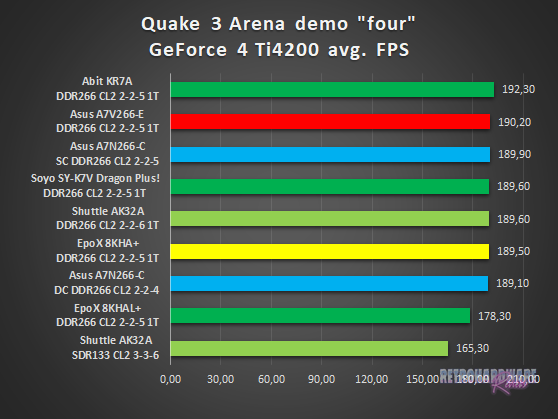

The Quake III Arena results are pretty close with the GeForce 4 Ti installed. In single channel memory configuration, the A7N266-C achieves third place. With only 0,8 FPS less in dual channel configuration it falls behind all KT266A boards except the EpoX 8KHAL+ as well as the Shuttle AK32A with SDR memory.
With the Voodoo 2 SLI setup on rendering duties, all boards basically reach the same level of performance (the A7N266-C is 0,1 FPS behind the KT266A based boards). The 3dfx cards are obviously limiting here.
Summary & Rating
Asus A7N266-C (nVidia nForce 415-D SPP)
-
Layout
-
Features
-
Overclocking Options
-
Compatibility
-
Documentation & Support
-
Performance: GeForce 4 Ti 4200
-
Performance: Voodoo 2 SLI
OVERALL
| Pros | Cons |
| + Good layout | – Memory compatibility and size limitations |
| + Great CPU support | – Fiddly driver installation |
| + Good performance, including PCI and IDE | – No support for 3,3V AGP graphics cards |
| + Onboard Ethernet | |
| + Quite good onboard audio |





